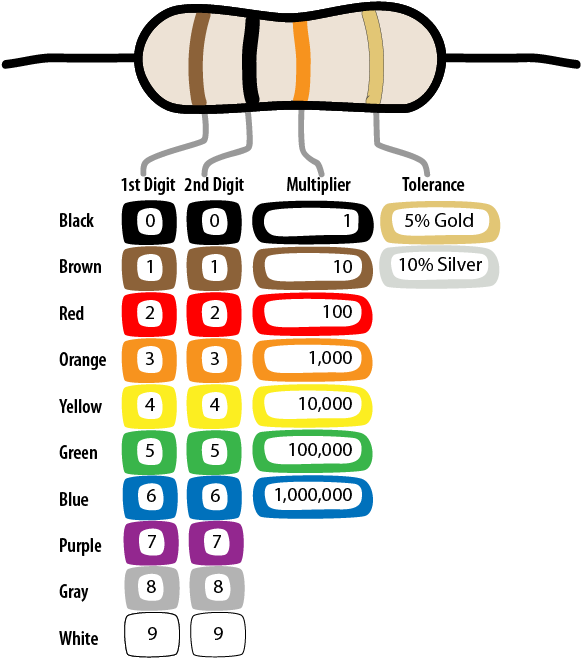Contents
- Home
- Interrupts 101
- Subreddit Monitor
- Reference
- Resistors
- Serial
Resistors
A resistor is an electronic component that, as its name implies, resists the flow of electricity through it.
Resistors are a basic component that can be used in many different way to produce many different effects. The main functions we will use them for is to limit current flow and divide voltages.
Detailed information about resistors can be found on Wikipedia.
Resistor Colour Coding
The degree to which resistors resist the flow of electricity is measured in ohms. The symbol for an ohm is: Ω
The number of ohms or the value of the resistor is identified by a series of coloured bands drawn on them. There are typically 4 or 5 bands, but you can sometimes get resistors with 6 bands. These bands indicate the value and accuracy (or tolerance) of the resistor:
- The first two (four band) or three (five band) are the value of the resistor
- The next one is a multiplier (e.g. x100 or x10 etc)
- The last one is the accuracy or tolerance of the resistor (e.g. +/- 5%)
The main resistors that we will be using will be as follows:
| Band colours | Image | ||||||
|---|---|---|---|---|---|---|---|
| 1st digit | 2nd digit | 3rd digit | Multiplier | Tolerance | |||
| 470 Ω | Four Bands | Yellow (4) | Violet (7) | Brown (x10) | Don't care | ||
| Five Bands | Yellow (4) | Violet (7) | Black (0) | Black (x1) | Don't care | ||
| 10 KΩ | Four Bands | Brown (1) | Black (0) | Orange (x1000) | Don't care | ||
| Five Bands | Brown (1) | Black (0) | Black (0) | Red (x100) | Don't care | ||
In relation to the tolerance values, it doesn't really matter what
the colour is for these projects.
Usually the tolerance bands will be coloured Gold (+/- 5%) or
Silver (+/- 10%). Other colours are tighter tolerances (i.e. < +/- 5%)
and are perfectly fine to use as well.
The complete set of colours used to identify resistors are as follows:

For example, a resistor with a White, Grey, Blue and gold would be
98 million Ω +/- 5% or 98 Mega ohms +/- 5%.
Another example is a resistor with a 3 red and one gold.
This is 2.2 KΩ +/- 5%. It is calculated as follows: 22 x 100 =
2,200 Ω. Since K, or kilo, is a prefix that means multiply by
1,000, we can express 2,200 Ω as 2.2 KΩ which is often simply
written as 2.2K.
A 2.2K ohm resistor with 5 bands would have the following colours:
red, red, black, brown and gold or silver (the tolerence doesn't really matter).
The value is calculated as follows 2 (red), 2 (red), 0 (black) x 10 (brown).
Or without the colour references in the calculation: 220 x 10Ω = 2,200Ω.